Using Geostationary Satellite Observations to Improve the Monitoring of Vegetation Phenology
Abstract
:1. Introduction
2. Data and Methods
2.1. Data
2.1.1. FY-4 ARGI Images
2.1.2. In Situ Measurements
2.2. Methods
2.2.1. Cloud-Free NDVI Construction
2.2.2. Retrieving the NDVI at Local Solar Noon
2.2.3. Construction of Different Time Series VI Curves
2.2.4. Phenological Information Extraction and Validation
3. Results
3.1. The Diurnal Variation in the FY-4 NDVI
3.2. Retrieval Results of Local Solar Noon NDVI (LSNVI)
3.3. The Seasonal Variation in Different VIs
3.4. Comparison Results of PTDs Derived from Different VIs
4. Discussion
4.1. Impacts of Solar Angles on Geostationary Satellite Data
4.2. Reconstructing NDVI at the Time of Cloud Cover with Cloud-Free NDVI at Other Time
4.3. Other Factors Affecting LSNVI Retrieval Modeling
5. Conclusions
Author Contributions
Funding
Data Availability Statement
Acknowledgments
Conflicts of Interest
References
- Zeng, L.; Wardlow, B.D.; Xiang, D.; Hu, S.; Li, D. A review of vegetation phenological metrics extraction using time-series, multispectral satellite data. Remote Sens. Environ. 2020, 237, 111511. [Google Scholar] [CrossRef]
- Richardson, A.D.; Keenan, T.F.; Migliavacca, M.; Ryu, Y.; Sonnentag, O.; Toomey, M. Climate change, phenology, and phenological control of vegetation feedbacks to the climate system. Agric. For. Meteorol. 2013, 169, 156–173. [Google Scholar] [CrossRef]
- Piao, S.; Liu, Q.; Chen, A.; Janssens, I.A.; Fu, Y.; Dai, J.; Liu, L.; Lian, X.; Shen, M.; Zhu, X. Plant phenology and global climate change: Current progresses and challenges. Glob. Chang. Biol. 2019, 25, 1922–1940. [Google Scholar] [CrossRef] [PubMed]
- Smith, W.K.; Dannenberg, M.P.; Yan, D.; Herrmann, S.; Barnes, M.L.; Barron-Gafford, G.A.; Biederman, J.A.; Ferrenberg, S.; Fox, A.M.; Hudson, A.; et al. Remote sensing of dryland ecosystem structure and function: Progress, challenges, and opportunities. Remote Sens. Environ. 2019, 233, 111401. [Google Scholar] [CrossRef]
- Chen, M.; Griffis, T.J.; Baker, J.; Wood, J.D.; Xiao, K. Simulating crop phenology in the Community Land Model and its impact on energy and carbon fluxes. J. Geophys. Res. Biogeosci. 2015, 120, 310–325. [Google Scholar] [CrossRef]
- Peng, D.; Wang, Y.; Xian, G.; Huete, A.R.; Huang, W.; Shen, M.; Wang, F.; Yu, L.; Liu, L.; Xie, Q.; et al. Investigation of land surface phenology detections in shrublands using multiple scale satellite data. Remote Sens. Environ. 2021, 252, 112133. [Google Scholar] [CrossRef]
- Zhang, X. Reconstruction of a complete global time series of daily vegetation index trajectory from long-term AVHRR data. Remote Sens. Environ. 2015, 156, 457–472. [Google Scholar] [CrossRef]
- Zhang, X.; Friedl, M.A.; Schaaf, C.B.; Strahler, A.H.; Hodges, J.C.F.; Gao, F.; Reed, B.C.; Huete, A.R. Monitoring vegetation phenology using MODIS. Remote Sens. Environ. 2003, 84, 471–475. [Google Scholar] [CrossRef]
- Zhang, X.; Liu, L.; Liu, Y.; Jayavelu, S.; Wang, J.; Moon, M.; Henebry, G.M.; Friedl, M.A.; Schaaf, C.B. Generation and evaluation of the VIIRS land surface phenology product. Remote Sens. Environ. 2018, 216, 212–229. [Google Scholar] [CrossRef]
- Zhang, X.; Liu, L.; Yan, D. Comparisons of global land surface seasonality and phenology derived from AVHRR, MODIS, and VIIRS data. J. Geophys. Res. Biogeosci. 2017, 122, 1506–1525. [Google Scholar] [CrossRef]
- Armitage, R.P.; Ramirez, F.A.; Danson, F.M.; Ogunbadewa, E.Y. Probability of cloud-free observation conditions across Great Britain estimated using MODIS cloud mask. Remote Sens. Lett. 2013, 4, 427–435. [Google Scholar] [CrossRef]
- Zhang, X.; Friedl, M.A.; Schaaf, C.B. Sensitivity of vegetation phenology detection to the temporal resolution of satellite data. Int. J. Remote Sens. 2009, 30, 2061–2074. [Google Scholar] [CrossRef]
- Quesada-Ruiz, S.; Chu, Y.; Tovar-Pescador, J.; Pedro, H.T.C.; Coimbra, C.F.M. Cloud-tracking methodology for intra-hour DNI forecasting. Sol. Energy. 2014, 102, 267–275. [Google Scholar] [CrossRef]
- Chow, C.W.; Belongie, S.; Kleissl, J. Cloud motion and stability estimation for intra-hour solar forecasting. Sol. Energy 2015, 115, 645–655. [Google Scholar] [CrossRef]
- Fensholt, R.; Anyamba, A.; Huber, S.; Proud, S.R.; Tucker, C.J.; Small, J.; Pak, E.; Rasmussen, M.O.; Sandholt, I.; Shisanya, C. Analysing the advantages of high temporal resolution geostationary MSG SEVIRI data compared to polar operational environmental satellite data for land surface monitoring in Africa. Int. J. Appl. Earth Obs. Geoinf. 2011, 13, 721–729. [Google Scholar] [CrossRef]
- Yan, D.; Zhang, X.; Yu, Y.; Guo, W. A comparison of tropical rainforest phenology retrieved from geostationary (SEVIRI) and polar-orbiting (MODIS) sensors across the Congo Basin. IEEE Trans. Geosci. Remote Sens. 2016, 54, 4867–4881. [Google Scholar] [CrossRef]
- Tian, J.; Zhu, X.; Chen, J.; Wang, C.; Shen, M.; Yang, W.; Tan, X.; Xu, S.; Li, Z. Improving the accuracy of spring phenology detection by optimally smoothing satellite vegetation index time series based on local cloud frequency. ISPRS J. Photogramm. Remote Sens. 2021, 180, 29–44. [Google Scholar] [CrossRef]
- Zhao, Y.; Wang, M.; Zhao, T.; Luo, Y.; Li, Y.; Yan, K.; Lu, L.; Tran, N.N.; Wu, X.; Ma, X. Evaluating the potential of H8/AHI geostationary observations for monitoring vegetation phenology over different ecosystem types in northern China. Int. J. Appl. Earth Obs. Geoinf. 2022, 112, 102933. [Google Scholar] [CrossRef]
- Miura, T.; Nagai, S.; Takeuchi, M.; Ichii, K.; Yoshioka, H. Improved characterisation of vegetation and land surface seasonal dynamics in central Japan with Himawari-8 hypertemporal data. Sci Rep. 2019, 9, 15692. [Google Scholar] [CrossRef]
- Hashimoto, H.; Wang, W.; Dungan, J.L.; Li, S.; Michaelis, A.R.; Takenaka, H.; Higuchi, A.; Myneni, R.B.; Nemani, R.R. New generation geostationary satellite observations support seasonality in greenness of the Amazon evergreen forests. Nat. Commun. 2021, 12, 684. [Google Scholar] [CrossRef]
- Wheeler, K.I.; Dietze, M.C. Improving the monitoring of deciduous broadleaf phenology using the Geostationary Operational Environmental Satellite (GOES) 16 and 17. Biogeosciences 2021, 18, 1971–1985. [Google Scholar] [CrossRef]
- Yan, D.; Zhang, X.; Nagai, S.; Yu, Y.; Akitsu, T.; Nasahara, K.N.; Ide, R.; Maeda, T. Evaluating land surface phenology from the Advanced Himawari Imager using observations from MODIS and the Phenological Eyes Network. Int. J. Appl. Earth Obs. Geoinf. 2019, 79, 71–83. [Google Scholar] [CrossRef]
- Tran, N.N.; Huete, A.R.; Nguyen, H.; Grant, I.; Miura, T.; Ma, X.; Lyapustin, A.; Wang, Y.; Ebert, E. Seasonal comparisons of Himawari-8 AHI and MODIS vegetation indices over latitudinal Australian grassland sites. Remote Sens. 2020, 12, 2494. [Google Scholar] [CrossRef]
- Li, Z.; Roy, D.P.; Zhang, H.K. The incidence and magnitude of the hot-spot bidirectional reflectance distribution function (BRDF) signature in GOES-16 Advanced Baseline Imager (ABI) 10 and 15 minute reflectance over north America. Remote Sens. Environ. 2021, 265, 112638. [Google Scholar] [CrossRef]
- Ma, X.; Huete, A.R.; Tran, N.; Bi, J.; Gao, S.; Zeng, Y. Sun-angle effects on remote-sensing phenology observed and modelled using Himawari-8. Remote Sens. 2020, 12, 1339. [Google Scholar] [CrossRef]
- Gao, F.; He, T.; Masek, J.G.; Shuai, Y.; Schaaf, C.B.; Wang, Z. Angular effects and correction for medium resolution sensors to support crop monitoring. IEEE J. Sel. Top. Appl. Earth Observ. Remote Sens. 2014, 7, 4480–4489. [Google Scholar] [CrossRef]
- Galvão, L.S.; Breunig, F.M.; Santos, J.R.; Moura, Y.M. View-illumination effects on hyperspectral vegetation indices in the Amazonian tropical forest. Int. J. Appl. Earth Obs. Geoinf. 2013, 21, 291–300. [Google Scholar] [CrossRef]
- Wheeler, K.I.; Dietze, M.C. A statistical model for estimating midday NDVI from the Geostationary Operational Environmental Satellite (GOES) 16 and 17. Remote Sens. 2019, 11, 2507. [Google Scholar] [CrossRef]
- Gao, F.; Jin, Y.F.; Li, X.W.; Schaaf, C.B.; Strahler, A.H. Bidirectional NDVI and atmospherically resistant BRDF inversion for vegetation canopy. IEEE Trans. Geosci. Remote Sens. 2002, 40, 1269–1278. [Google Scholar]
- Walthall, C.L.; Norman, J.M.; Welles, J.M.; Campbell, G.; Blad, B.L. Simple quation to approximate the bidirectional reflectance from vegetative canopies and bare soil surfaces. Appl. Opt. 1985, 24, 383–387. [Google Scholar] [CrossRef]
- Lunagaria, M.M. Parameter estimation and evaluation of Ross-Li and RPV models for wheat phenophases using hemispherical directional reflectance measurements. Int. J. Remote Sens. 2020, 41, 3627–3651. [Google Scholar] [CrossRef]
- Yang, J.; Zhang, Z.; Wei, C.; Lu, F.; Guo, Q. Introduction the new generation of Chinese geostationary weather satellites, Fengyun-4. Bull. Amer. Meteorol. Soc. 2017, 98, 1637–1658. [Google Scholar] [CrossRef]
- Hufkens, K.; Melaas, E.K.; Mann, M.L.; Foster, T.; Ceballos, F.; Robles, M.; Kramer, B. Monitoring crop phenology using a smartphone based near-surface remote sensing approach. Agric. For. Meteorol. 2019, 265, 327–337. [Google Scholar] [CrossRef]
- Julitta, T.; Cremonese, E.; Migliavacca, M.; Colombo, R.; Galvagno, M.; Siniscalco, C.; Rossini, M.; Fava, F.; Cogliati, S.; di Cella, U.M.; et al. Using digital camera images to analyse snowmelt and phenology of a subalpine grassland. Agric. For. Meteorol. 2014, 198, 116–125. [Google Scholar] [CrossRef]
- Liu, S.; Xu, Z.; Che, T.; Li, X.; Xu, T.; Ren, Z.; Zhang, Y.; Tan, J.; Song, L.; Zhou, J.; et al. A dataset of energy, water vapor, and carbon exchange observations in oasis–desert areas from 2012 to 2021 in a typical endorheic basin. Earth Syst. Sci. Data. 2023, 15, 4959–4981. [Google Scholar] [CrossRef]
- Ma, X.; Huete, A.R.; Tran, N.N. Interaction of seasonal sun-angle and savanna phenology observed and modelled using MODIS. Remote Sens. 2019, 11, 1398. [Google Scholar] [CrossRef]
- Jacquemoud, S.; Verhoef, W.; Baret, F.; Bacour, C.; Zarco-Tejada, P.J.; Asner, G.P.; François, C.; Ustin, S.L. PROSPECT+SAIL models: A review of use for vegetation characterization. Remote Sens. Environ. 2009, 113, S56–S66. [Google Scholar] [CrossRef]
- Wanner, W.; Li, X.; Strahler, A.H. On the derivation of kernels for kernel-driven models of bidirectional reflectance. J. Geophys. Res. Atmos. 1995, 100, 21077–21089. [Google Scholar] [CrossRef]
- Tian, Y.; Romanov, P.; Yu, Y.; Xu, H.; Tarpley, D. Analysis of vegetation index NDVI anisotropy to improve the accuracy of the GOES-R green vegetation fraction product. In Proceedings of the 30th IEEE International Geoscience and Remote Sensing Symposium (IGARSS) on Remote Sensing—Global Vision for Local Action, Honolulu, HI, USA, 25–30 July 2010. [Google Scholar]
- Chen, J.; Jonsson, P.; Tamura, M.; Gu, Z.H.; Matsushita, B.; Eklundh, L. A simple method for reconstructing a high-quality NDVI time-series data set based on the Savitzky-Golay filter. Remote Sens. Environ. 2004, 91, 332–344. [Google Scholar] [CrossRef]
- Wang, Z.; Schaaf, C.B.; Sun, Q.; Shuai, Y.; Roman, M.O. Capturing rapid land surface dynamics with Collection V006 MODIS BRDF/NBAR/Albedo (MCD43) products. Remote Sens. Environ. 2018, 207, 50–64. [Google Scholar] [CrossRef]
- Li, X.; Weng, Y.; Huang, X.; Wu, Q. Analyzing Sunlight Effect on BRDF Characteristics Using Hyperspectral Data. Remote Sens. 2013, 3, 1143–1156. [Google Scholar]
- Chen, X.; Wang, D.; Chen, J.; Wang, C.; Shen, M. The mixed pixel effect in land surface phenology: A simulation study. Remote Sens. Environ. 2018, 211, 338–344. [Google Scholar] [CrossRef]
- Ma, Y.; He, T.; Li, A.; Li, S. Evaluation and intercomparison of topographic correction methods based on Landsat images and simulated data. Remote Sens. 2021, 13, 4120. [Google Scholar] [CrossRef]
- Ma, Y.; He, T.; Liang, S.; Xiao, X. Quantifying the impacts of DEM uncertainty on clear-sky surface shortwave radiation estimation in typical mountainous areas. Agric. For. Meteorol. 2022, 327, 109222. [Google Scholar] [CrossRef]
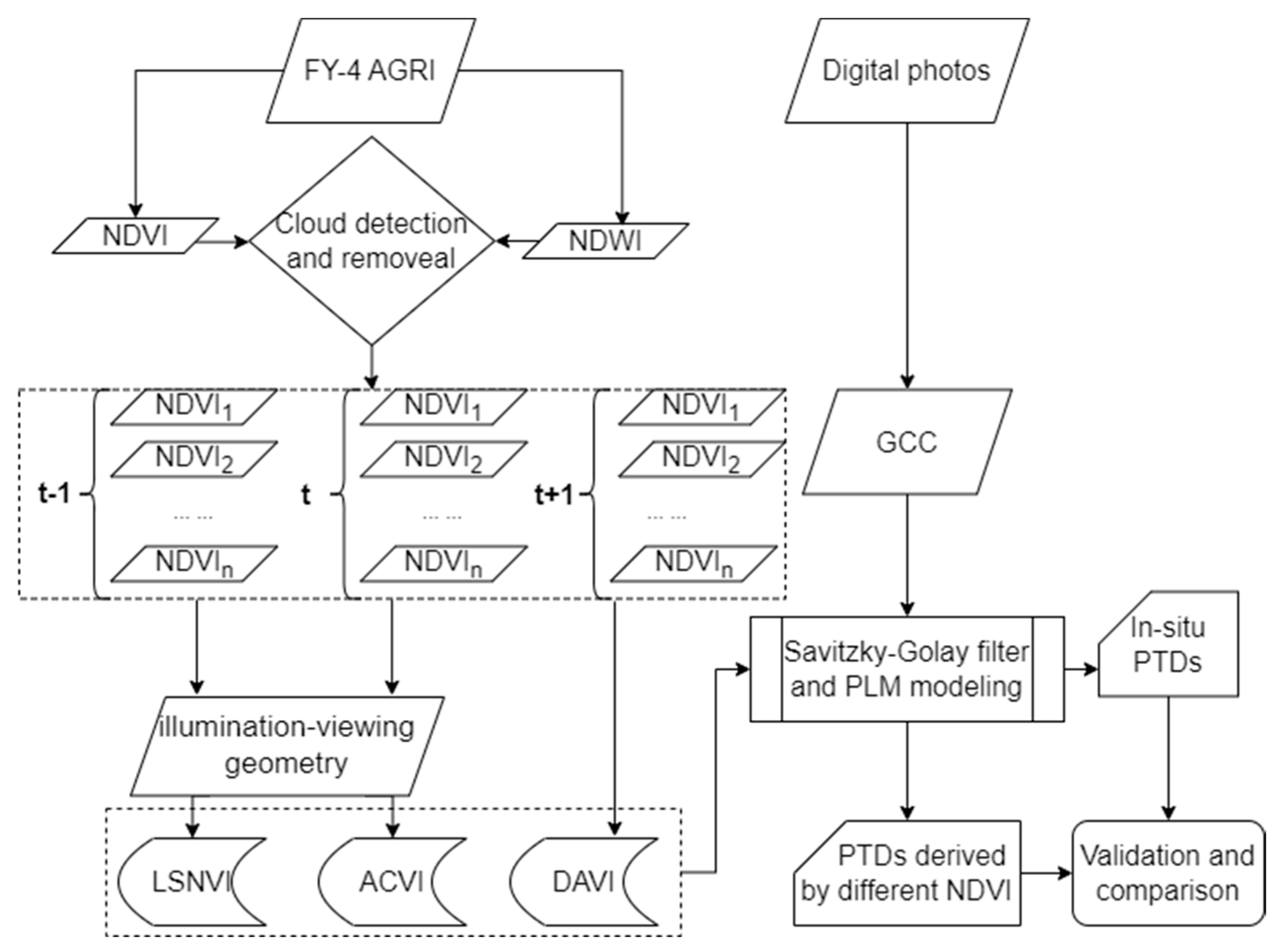
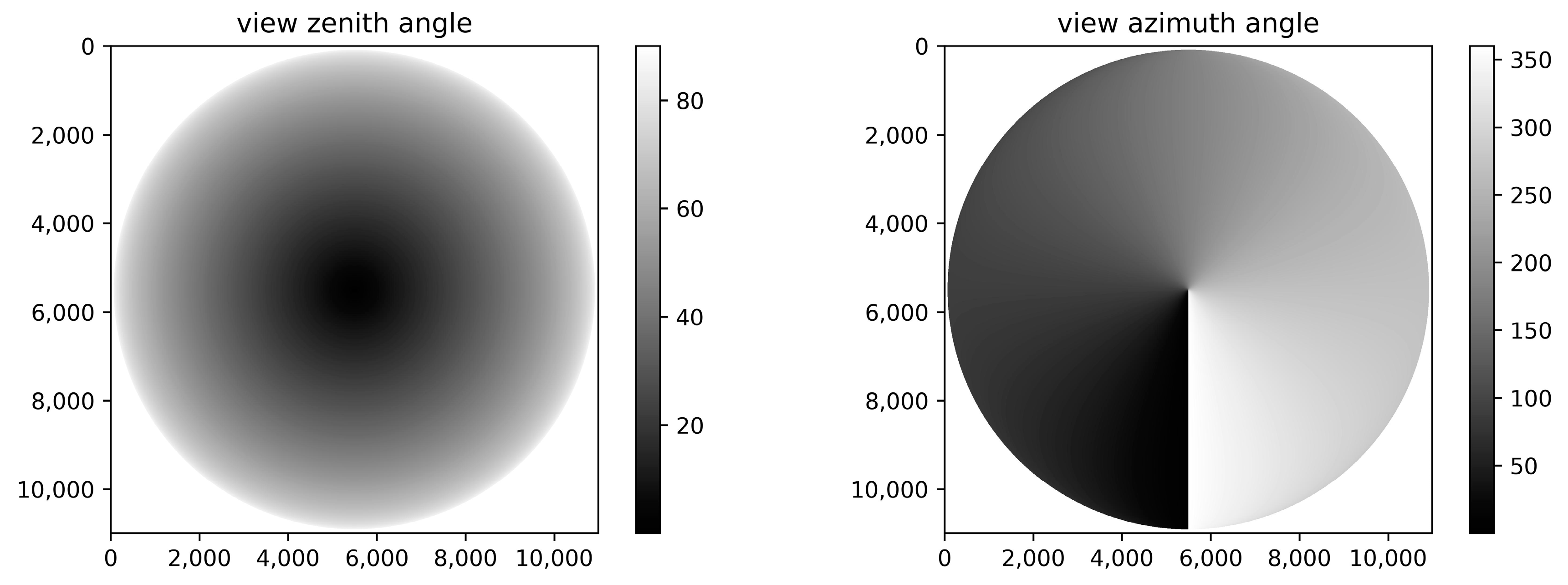
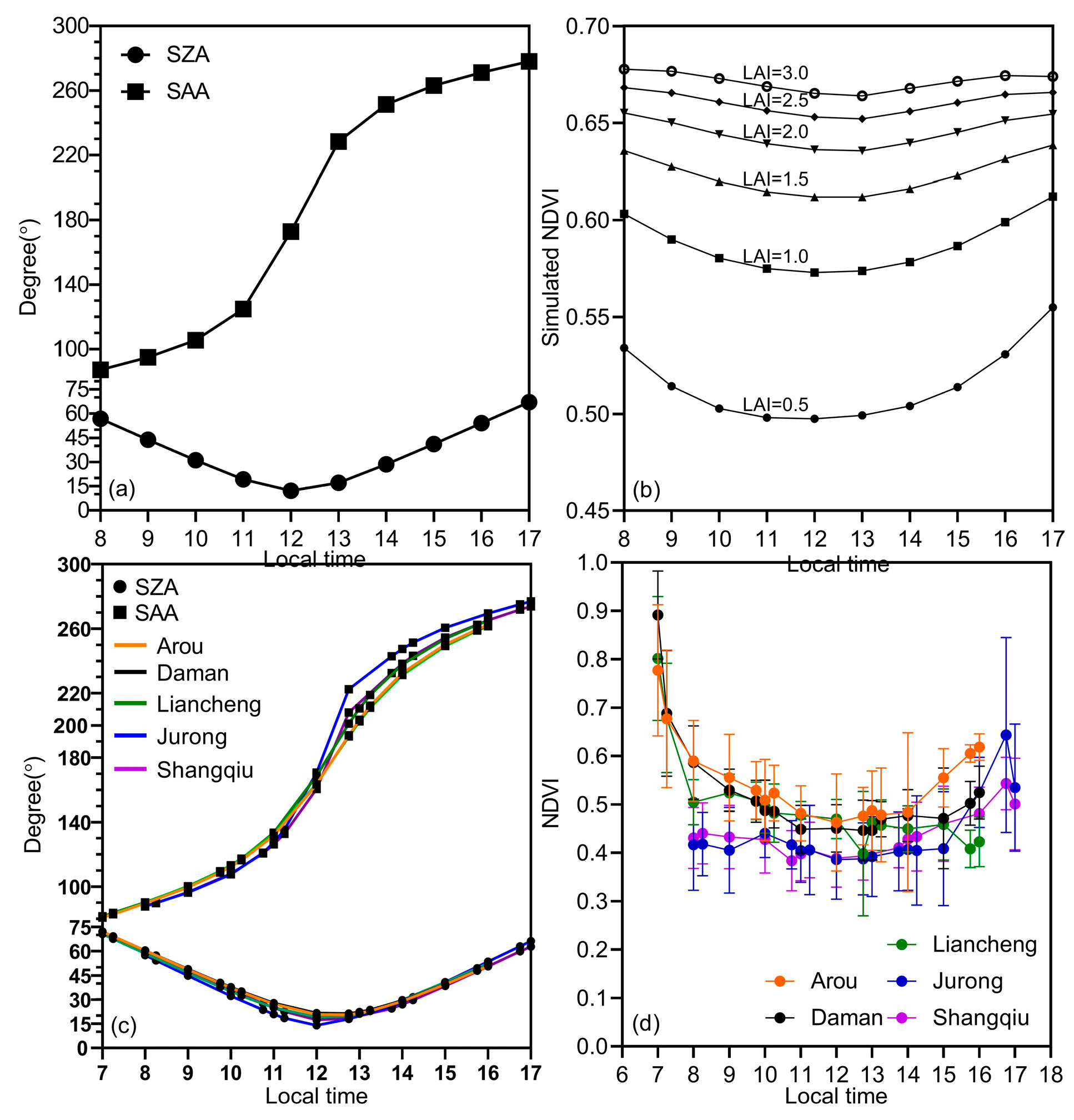
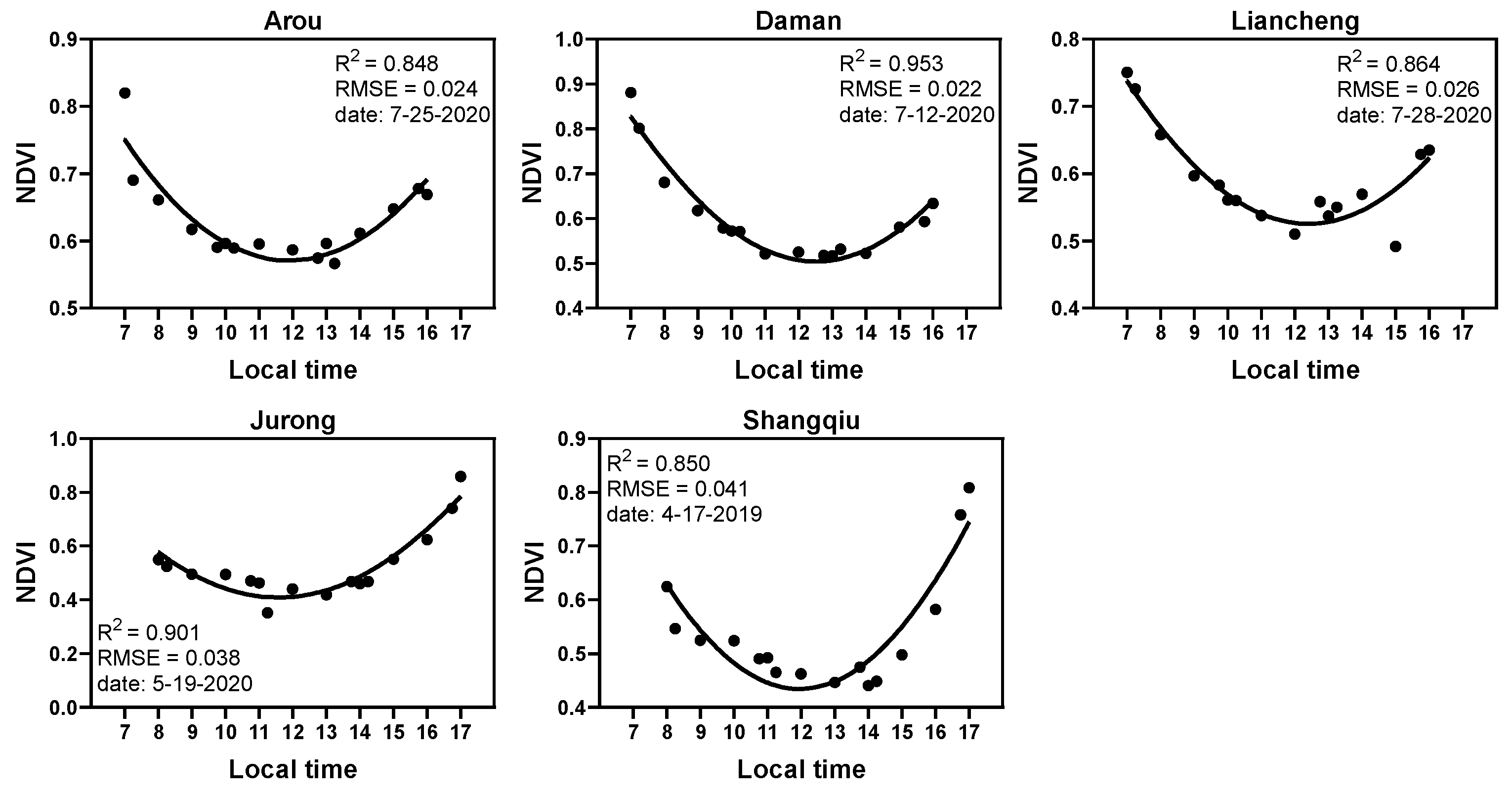

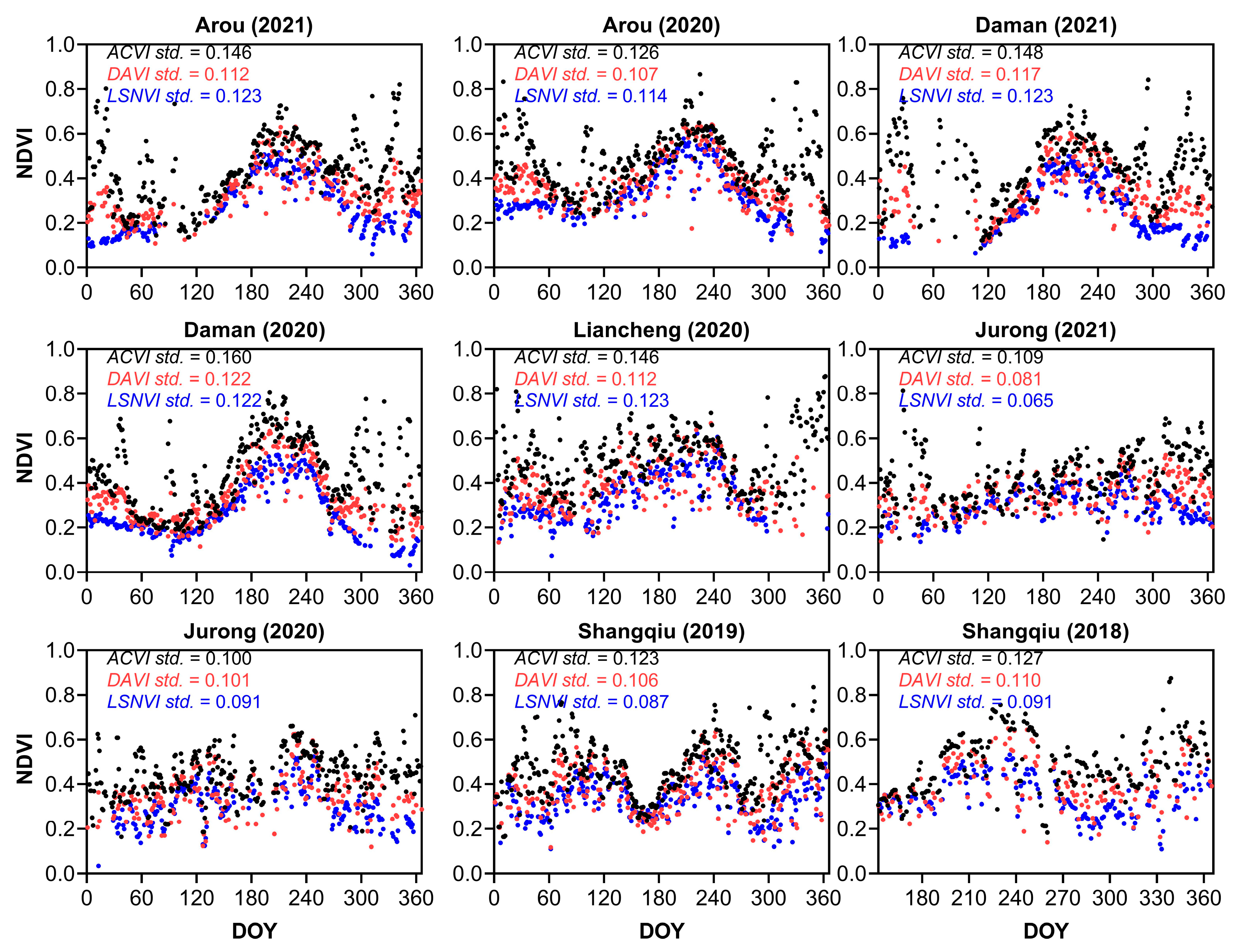
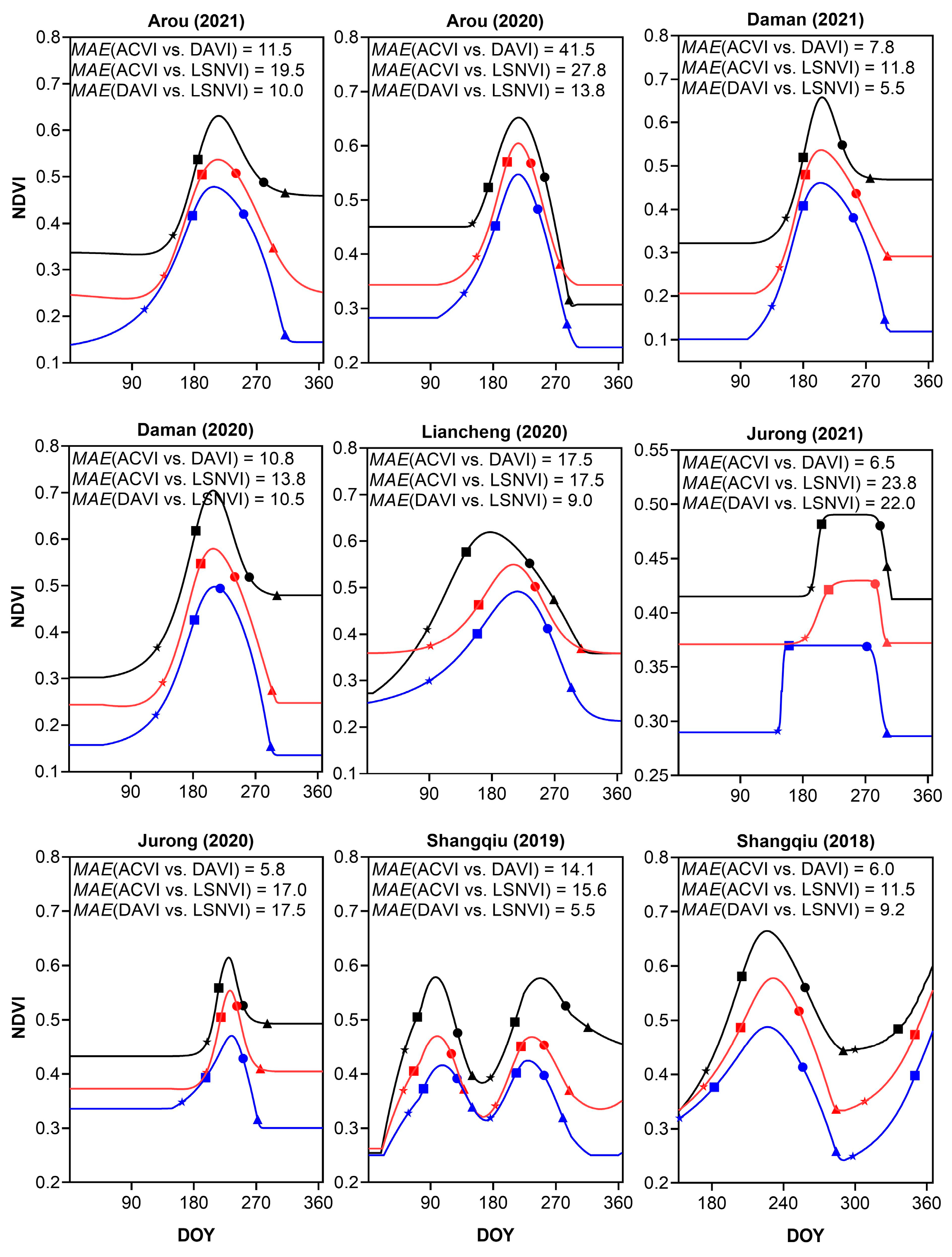

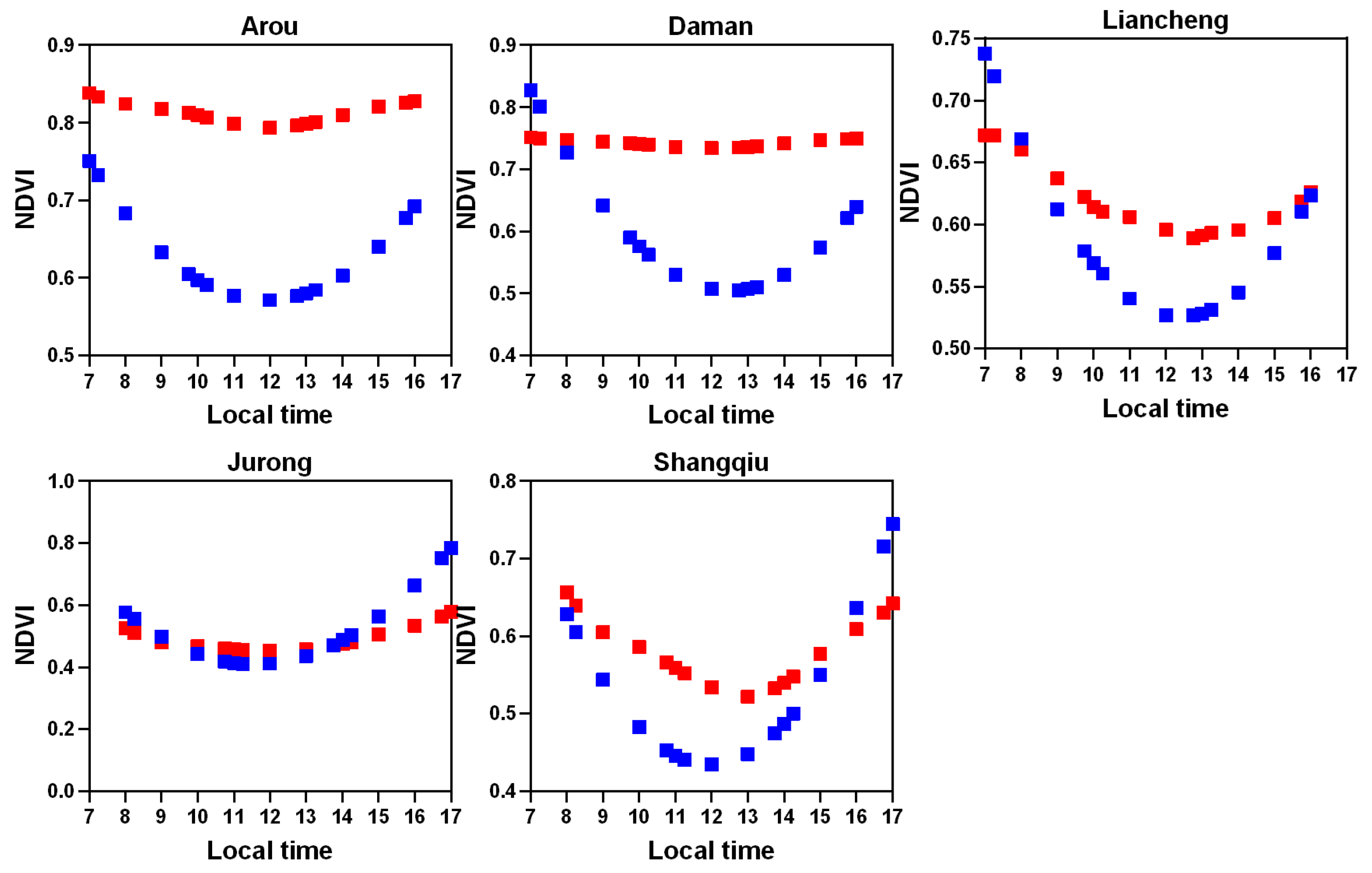
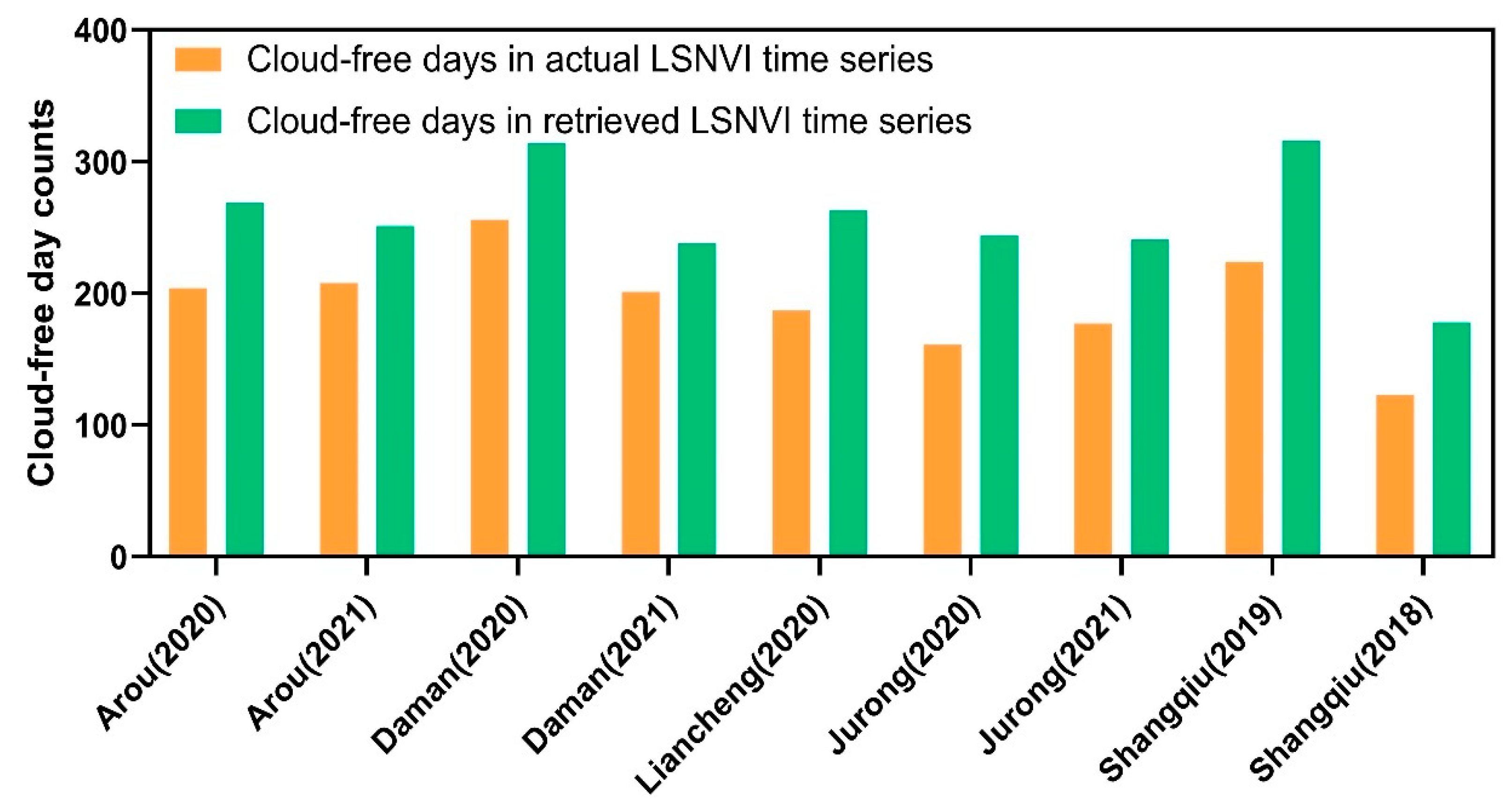
| Site Name | Longitude | Latitude | VZA | VAA | Altitude | Period (YYYY.MM) | Vegetation Types |
|---|---|---|---|---|---|---|---|
| Arou | 100.464°E | 38.047°N | 44.3128 | 173.148 | 3033 | 2020.01–2021.12 | grassland |
| Daman | 100.372°E | 38.856°N | 45.222 | 173.122 | 1556 | 2020.01–2021.12 | cropland |
| Liancheng | 102.737°E | 36.692°N | 42.6157 | 176.717 | 2903 | 2020.01–2020.12 | meadow |
| Jurong | 119.217°E | 31.807°N | 40.2538 | 206.165 | 15 | 2020.01–2021.12 | cropland |
| Shangqiu | 115.592°E | 34.520°N | 41.7774 | 198.755 | 55 | 2018.06–2019.12 | cropland |
| Parameter | Description of Parameter | Units | Value |
|---|---|---|---|
| Typelidf | Leaf angle distribution type | N/A | 2 |
| LIDFa | Average leaf angle | degree | 30 |
| LIDFb | Leaf distribution’s bimodality | N/A | 0 |
| Cab | Chlorophyll a + b concentration | μg/cm2 | 40 |
| Car | Carotenoid concentration | μg/cm2 | 8 |
| Ant | Carotenoid concentration | μg/cm2 | 0 |
| Cbrown | Brown pigment content | N/A | 0 |
| Cw | Equivalent water thickness | cm | 0.01 |
| Cm | Dry matter content | g/cm2 | 0.009 |
| N | Leaf structure coefficient | N/A | 1.5 |
| Rsoil1 | Soil reflectance properties | N/A | Dry soil |
| Rsoil2 | Soil reflectance properties | N/A | Wet soil |
| psoil | Soil reflectance properties | N/A | 1 |
| rsoil0 | Soil reflectance properties | N/A | psoil × Rsoil1 + (1 − psil)*Rsoil2 |
| LAI | Leaf area index | N/A | 0.5, 1.0, 1.5, 2.0, 2.5, 3.0 |
| hspot | Hotspot parameter | N/A | 0.01 |
| tts | Solar zenith angle | degree | 56.867, 43.901, 31.131, 19.328, 12.175, 17.203, 28.549, 41.220, 54.182, 67.110 |
| tto | View zenith angle | degree | 30 |
| psi | Relative azimuth angle | degree | 92.768, 85.015, 74.439, 55.067, 7.111, 48.330, 71.397, 83.048, 91.166, 98.097 |
Disclaimer/Publisher’s Note: The statements, opinions and data contained in all publications are solely those of the individual author(s) and contributor(s) and not of MDPI and/or the editor(s). MDPI and/or the editor(s) disclaim responsibility for any injury to people or property resulting from any ideas, methods, instructions or products referred to in the content. |
© 2024 by the authors. Licensee MDPI, Basel, Switzerland. This article is an open access article distributed under the terms and conditions of the Creative Commons Attribution (CC BY) license (https://creativecommons.org/licenses/by/4.0/).
Share and Cite
Lu, J.; He, T.; Song, D.-X.; Wang, C.-Q. Using Geostationary Satellite Observations to Improve the Monitoring of Vegetation Phenology. Remote Sens. 2024, 16, 2173. https://doi.org/10.3390/rs16122173
Lu J, He T, Song D-X, Wang C-Q. Using Geostationary Satellite Observations to Improve the Monitoring of Vegetation Phenology. Remote Sensing. 2024; 16(12):2173. https://doi.org/10.3390/rs16122173
Chicago/Turabian StyleLu, Jun, Tao He, Dan-Xia Song, and Cai-Qun Wang. 2024. "Using Geostationary Satellite Observations to Improve the Monitoring of Vegetation Phenology" Remote Sensing 16, no. 12: 2173. https://doi.org/10.3390/rs16122173





